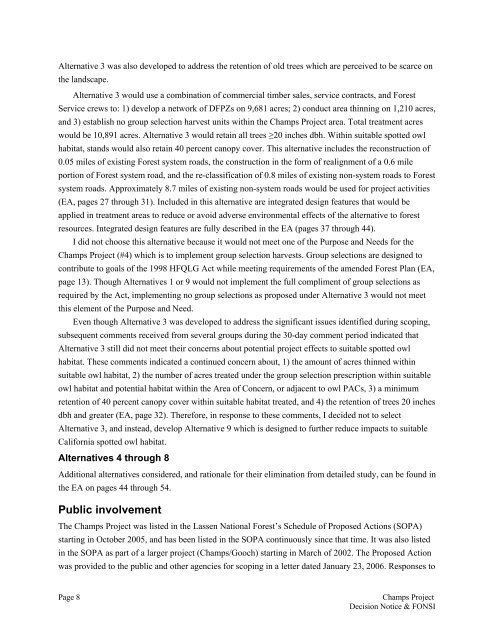Champs Project
Champs Project
Champs Project
You also want an ePaper? Increase the reach of your titles
YUMPU automatically turns print PDFs into web optimized ePapers that Google loves.
Alternative 3 was also developed to address the retention of old trees which are perceived to be scarce on<br />
the landscape.<br />
Alternative 3 would use a combination of commercial timber sales, service contracts, and Forest<br />
Service crews to: 1) develop a network of DFPZs on 9,681 acres; 2) conduct area thinning on 1,210 acres,<br />
and 3) establish no group selection harvest units within the <strong>Champs</strong> <strong>Project</strong> area. Total treatment acres<br />
would be 10,891 acres. Alternative 3 would retain all trees ≥20 inches dbh. Within suitable spotted owl<br />
habitat, stands would also retain 40 percent canopy cover. This alternative includes the reconstruction of<br />
0.05 miles of existing Forest system roads, the construction in the form of realignment of a 0.6 mile<br />
portion of Forest system road, and the re-classification of 0.8 miles of existing non-system roads to Forest<br />
system roads. Approximately 8.7 miles of existing non-system roads would be used for project activities<br />
(EA, pages 27 through 31). Included in this alternative are integrated design features that would be<br />
applied in treatment areas to reduce or avoid adverse environmental effects of the alternative to forest<br />
resources. Integrated design features are fully described in the EA (pages 37 through 44).<br />
I did not choose this alternative because it would not meet one of the Purpose and Needs for the<br />
<strong>Champs</strong> <strong>Project</strong> (#4) which is to implement group selection harvests. Group selections are designed to<br />
contribute to goals of the 1998 HFQLG Act while meeting requirements of the amended Forest Plan (EA,<br />
page 13). Though Alternatives 1 or 9 would not implement the full compliment of group selections as<br />
required by the Act, implementing no group selections as proposed under Alternative 3 would not meet<br />
this element of the Purpose and Need.<br />
Even though Alternative 3 was developed to address the significant issues identified during scoping,<br />
subsequent comments received from several groups during the 30-day comment period indicated that<br />
Alternative 3 still did not meet their concerns about potential project effects to suitable spotted owl<br />
habitat. These comments indicated a continued concern about, 1) the amount of acres thinned within<br />
suitable owl habitat, 2) the number of acres treated under the group selection prescription within suitable<br />
owl habitat and potential habitat within the Area of Concern, or adjacent to owl PACs, 3) a minimum<br />
retention of 40 percent canopy cover within suitable habitat treated, and 4) the retention of trees 20 inches<br />
dbh and greater (EA, page 32). Therefore, in response to these comments, I decided not to select<br />
Alternative 3, and instead, develop Alternative 9 which is designed to further reduce impacts to suitable<br />
California spotted owl habitat.<br />
Alternatives 4 through 8<br />
Additional alternatives considered, and rationale for their elimination from detailed study, can be found in<br />
the EA on pages 44 through 54.<br />
Public involvement<br />
The <strong>Champs</strong> <strong>Project</strong> was listed in the Lassen National Forest’s Schedule of Proposed Actions (SOPA)<br />
starting in October 2005, and has been listed in the SOPA continuously since that time. It was also listed<br />
in the SOPA as part of a larger project (<strong>Champs</strong>/Gooch) starting in March of 2002. The Proposed Action<br />
was provided to the public and other agencies for scoping in a letter dated January 23, 2006. Responses to<br />
Page 8 <strong>Champs</strong> <strong>Project</strong><br />
Decision Notice & FONSI
















